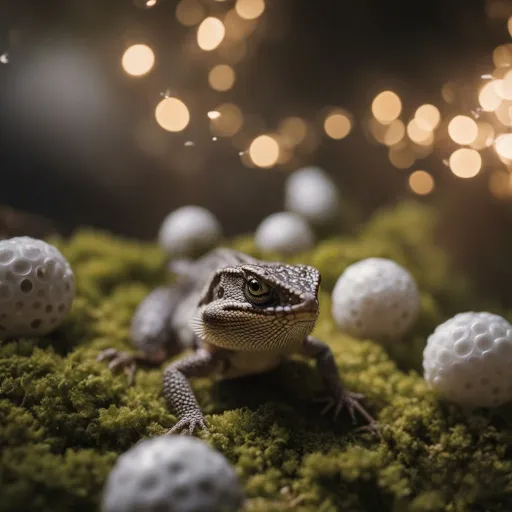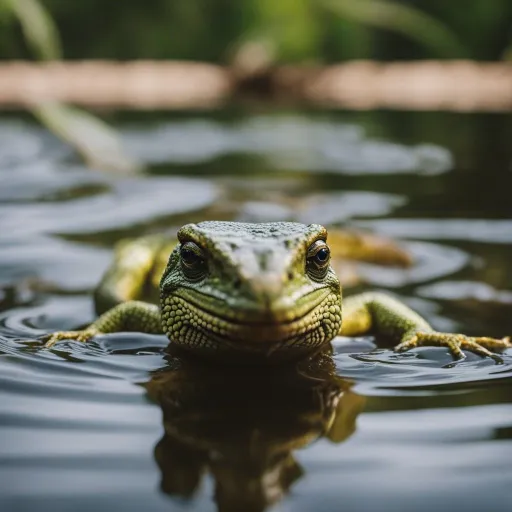So, you’re wondering if moth balls can keep those unwanted lizards away, huh? Well, you’re not alone. Many people have tried all sorts of methods to keep these scaly creatures from invading their homes and gardens.
And one popular notion that has been circulating is that moth balls, with their strong smell, can repel lizards.
But is there any truth to this claim? In this article, we’ll examine whether or not moth balls are really effective in keeping those slippery intruders at bay.
Stick around to find out if moth balls are your secret weapon against lizards, or just a stinky illusion.

What are Moth Balls?
Moth balls are small, white, pungent-scented balls made from either naphthalene or paradichlorobenzene.
They are commonly used to protect clothing and other textiles from damage caused by moths and other fabric-eating insects.
Moth balls release a strong odor that repels various insects, including moths. However, some people claim that these repellent properties extend to lizards as well.
Composition of Moth Balls
Moth balls are typically composed of either naphthalene or paradichlorobenzene. Naphthalene has a strong, distinctive odor and is derived from coal tar, while paradichlorobenzene is a white crystalline solid with a pungent odor. Both substances are volatile and release gases that are effective in deterring insects and fabric pests. These chemicals work by disrupting the nervous system of insects, causing them to avoid the area where the moth balls are placed.
Use of Moth Balls
Moth balls have long been used as a traditional method to protect clothing in storage from moth damage. They are typically placed in closets, drawers, or storage boxes to repel moths and other fabric pests. However, some individuals have also reported success in using moth balls to repel lizards from their homes or outdoor areas. This practice is based on the belief that the strong odor of moth balls is unpleasant to lizards, causing them to avoid the vicinity.
Lizard Behavior and Habits
Overview of Lizards
Lizards are reptiles belonging to the Squamata order and are found in various habitats around the world. They are known for their scaly skin, four legs, and ability to regenerate their tails. Lizards exhibit a wide range of behaviors and habits, depending on the species. Some lizards are primarily active during the day (diurnal), while others are active at night (nocturnal). They vary in diet, with some species being herbivorous, while others are carnivorous or omnivorous.
Factors that Attract Lizards
Lizards are attracted to areas that provide suitable living conditions, such as a steady food source, water, and shelter. They are often drawn to environments with abundant insect populations, as they are natural predators of insects. Lizards are also attracted to areas with suitable temperature and humidity levels, as these factors are crucial for their survival and reproduction. In residential areas, lizards may find shelter in gardens, cracks or gaps in structures, or overgrown vegetation.
Lizards as Pests
While lizards are generally harmless creatures that play important roles in controlling insect populations, they can sometimes become pests in certain situations. For example, lizards may cause damage to property by leaving droppings or shedding skin, which can be unsightly and difficult to clean. Some species of lizards can also be aggressive towards humans or pets, posing potential risks. In situations where lizards are unwanted or causing problems, people may explore various methods to repel or control their presence.
Claims about Moth Balls Repelling Lizards
Explanation of the Claim
The claim that moth balls can repel lizards is based on the belief that the strong odor emitted by moth balls is unpleasant for lizards, causing them to avoid the area where the moth balls are placed. The argument is that the powerful scent of moth balls, which is effective in deterring moths and other fabric pests, can also deter lizards due to their sensitive olfactory system. It is suggested that by strategically placing moth balls in problematic areas, one can effectively keep lizards at bay.
Common Myths about Moth Balls
There are several myths surrounding the use of moth balls as a lizard repellent. One common misconception is that moth balls can kill lizards. While moth balls are toxic to some organisms, such as insects, their effect on lizards is less clear. Another myth is that the smell of moth balls can cause lizards to suffocate or pass out. However, lizards have a highly developed respiratory system and are unlikely to be affected in such a manner by the scent of moth balls.
Limited Scientific Evidence
Despite the widespread belief in the efficacy of moth balls in repelling lizards, there is limited scientific evidence to support this claim. Most of the available research has focused on the use of moth balls for insect control rather than lizard repellency. Therefore, while anecdotal evidence and personal experiences suggest that moth balls may deter lizards, more scientific studies are needed to establish a definitive link.
Understanding the Effects of Moth Balls on Lizards
Toxicity of Moth Balls
Moth balls contain toxic chemicals, such as naphthalene or paradichlorobenzene, which can be harmful if ingested, inhaled, or absorbed through the skin. These chemicals can cause various health issues ranging from irritation to more severe symptoms, depending on the concentration and duration of exposure. It is important to note that the toxicity of moth balls is primarily determined by the active ingredient used, with paradichlorobenzene generally considered less toxic than naphthalene.
Potential Harm to Lizards
While there is limited scientific research specifically addressing the effects of moth balls on lizards, the toxic nature of the chemicals used suggests that prolonged exposure to moth balls could potentially harm lizards. Ingesting or inhaling the toxic fumes emitted by moth balls may lead to respiratory issues, organ damage, or even death in extreme cases. Additionally, direct contact with moth balls could irritate a lizard’s skin, eyes, or digestive system, causing discomfort or complications.
Effects on Lizard Behavior
The scent of moth balls may have some impact on lizard behavior, but the extent and consistency of these effects remain uncertain. It is possible that the strong odor could temporarily deter lizards from entering or remaining in areas treated with moth balls. However, lizards are known to adapt to various stimuli over time, including scents, so it is unclear how long the repellent effect would last. The effectiveness of moth balls as a long-term solution for lizard control is still open to debate.
Alternate Methods for Lizard Control
Natural Lizard Repellents
There are various natural substances that some individuals claim can repel lizards. These include coffee grounds, vinegar, citrus peels, garlic, onion, and certain essential oils. However, it is important to note that the effectiveness of these natural remedies may vary and is often based on anecdotal evidence rather than scientific research. Furthermore, natural repellents may require frequent reapplication and may not provide long-lasting results.
Sealing Entry Points
Preventing lizards from entering buildings or specific areas can be achieved by sealing any gaps, cracks, or openings in walls, windows, doors, or roofs. Lizards are known for their ability to squeeze through small gaps, so a thorough inspection and proper sealing of potential entry points is essential. This method focuses on creating a physical barrier to keep lizards out, rather than relying on repellents or trapping methods.
Reducing Food and Water Sources
One effective way to discourage lizards from frequenting an area is to eliminate their food and water sources. By reducing insect populations through proper sanitation and pest control practices, such as regular cleaning and maintenance, removing clutter, and limited outdoor lighting, the attractiveness of the environment to lizards is diminished. Additionally, fixing any leaks or sources of standing water can help reduce the availability of water for lizards.
Exclusion Methods
Exclusion methods involve creating barriers or deterrents that prevent lizards from accessing certain areas. This can be achieved through the use of physical barriers, such as wire mesh or fencing, or by implementing visual deterrents, such as reflective surfaces or predator decoys. These methods aim to make the environment less conducive to lizards, thereby discouraging their presence.
Professional Pest Control
In cases where lizards persistently invade a property or are causing significant problems, it may be necessary to seek professional pest control services. Pest control professionals have the expertise and resources to assess the situation, identify the most appropriate measures, and implement effective strategies for lizard control. They can provide a tailored and comprehensive approach to managing lizard populations while considering potential health and safety risks.
Safety Considerations
Health Risks of Moth Balls
Moth balls pose several health risks to humans and animals, including lizards. The ingestion, inhalation, or dermal exposure to toxic chemicals in moth balls can lead to various health issues, such as respiratory problems, skin irritation, nausea, and even organ damage. Individuals with pre-existing respiratory conditions, children, and pets are particularly vulnerable. It is crucial to follow safety guidelines and consider the potential risks before using moth balls as a lizard repellent.
Proper Usage and Storage
If using moth balls, it is important to follow the manufacturer’s instructions for proper usage. Moth balls should be placed in well-ventilated areas and not in direct contact with fabric or other materials. When storing moth balls, they should be kept in a secure container away from children and pets. It is also advisable to wear protective gloves when handling moth balls to minimize skin contact and wash hands thoroughly afterward.
Preventing Exposure
To minimize the potential risks of using moth balls, it is important to consider alternative methods for lizard control or seek professional assistance. Prioritize preventive measures, such as sealing entry points and reducing food and water sources, before resorting to potentially harmful chemicals. If exposure to moth balls occurs, ventilate the area, remove the source of exposure, and seek medical attention if symptoms persist or worsen.

Home Remedies and DIY Solutions
Pepper Spray
Pepper spray is a natural deterrent that can be prepared using chili peppers or pepper powders mixed with water. While this solution may cause temporary discomfort or irritation to lizards, it is important to consider the potential risks to other individuals or pets in the vicinity. Pepper spray should be used with caution and in accordance with local laws and regulations.
Vinegar or Citric Acid Solution
A solution made with vinegar or citric acid, such as lemon juice, can be sprayed in areas where lizards are unwanted. The strong scent of vinegar or citric acid may deter lizards. However, the effectiveness of this solution is variable, and it may require frequent reapplication to maintain the repellent effect.
Garlic and Onion Repellent
Garlic and onion are known for their pungent odor, which some individuals claim can deter lizards. Crushed garlic cloves or onion slices can be placed in problem areas to create a barrier that repels lizards. However, the potency of the odor may diminish over time, requiring regular replacement.
Use of Essential Oils
Certain essential oils, such as lavender, peppermint, or tea tree oil, are believed to repel lizards due to their strong scents. These oils can be diluted with water and sprayed in areas where lizards are present. However, it is important to use essential oils with caution, as they can be toxic if ingested or cause skin irritation in concentrated forms.
Ultrasonic Devices
Ultrasonic devices emit high-frequency sound waves that are claimed to repel lizards and other pests. These devices are typically battery-powered and can be placed in problem areas or attached to walls. While some people report success with ultrasonic devices, their effectiveness may vary depending on factors such as room layout, lizard species, and environmental conditions.
Final Thoughts
While the claim that moth balls can repel lizards may be supported by anecdotal evidence, scientific research on this topic is limited.
Moth balls contain toxic chemicals that can be harmful to both humans and lizards. Additionally, there are numerous alternative methods available for lizard control, ranging from natural repellents to professional pest control services.
When dealing with lizard issues, it is essential to prioritize safety, consider the potential risks and benefits of each method, and choose a comprehensive approach that aligns with your specific situation.
Ultimately, seeking guidance from professionals or local experts can help ensure effective and humane lizard control measures are implemented.



